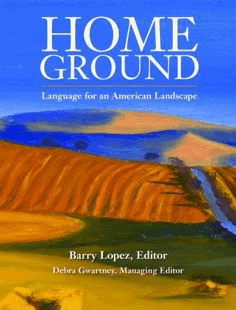Language of Landscape
Air Date: Week of September 25, 2009

Living on Earth continues its series exploring features of the American landscape. It’s based on the book “Home Ground: Language for an American Landscape,” edited by Barry Lopez and Debra Gwartney. In this installment, Donna Seaman explains the term “chop hills.”
Transcript
CURWOOD: The landscape out in the West where the aspens are dying is stark, beautiful and idiosyncratic. The particular and iconic features of American geography inspired the book “Home Ground, Language for an American Landscape.” And that, in turn, inspired us to bring you occasional definitions from the book. Today, writer Donna Seaman describes Chop Hills.

SEAMAN: Chop Hills. Nebraskans use the term ‘chop hills’ as an alternative to sand hills; both refer to a ridge of sand, or sand dune, in a region containing a series of hills, either composed of or covered with sand. Nebraska’s Sand Hills form a body of sandy landforms north and northwest of the confluence of the North and South forks of the Platte River and include the marshes the hills nourish. The famed sandhill cranes, wading birds averaging four feet in height with gray plumage, a trumpeting call, and elaborately choreographed mating rituals, frequent the chop hills as a way station on their annual migrations.
CURWOOD: Donna Seaman is a writer and editor based in Illinois. Her definition of Chop Hills comes from the book “Home Ground: Language for an American Landscape,” edited by Barry Lopez and Debra Gwartney.
Living on Earth wants to hear from you!
Living on Earth
62 Calef Highway, Suite 212
Lee, NH 03861
Telephone: 617-287-4121
E-mail: comments@loe.org
Newsletter [Click here]
Donate to Living on Earth!
Living on Earth is an independent media program and relies entirely on contributions from listeners and institutions supporting public service. Please donate now to preserve an independent environmental voice.
NewsletterLiving on Earth offers a weekly delivery of the show's rundown to your mailbox. Sign up for our newsletter today!
 Sailors For The Sea: Be the change you want to sea.
Sailors For The Sea: Be the change you want to sea.
 The Grantham Foundation for the Protection of the Environment: Committed to protecting and improving the health of the global environment.
The Grantham Foundation for the Protection of the Environment: Committed to protecting and improving the health of the global environment.
 Contribute to Living on Earth and receive, as our gift to you, an archival print of one of Mark Seth Lender's extraordinary wildlife photographs. Follow the link to see Mark's current collection of photographs.
Contribute to Living on Earth and receive, as our gift to you, an archival print of one of Mark Seth Lender's extraordinary wildlife photographs. Follow the link to see Mark's current collection of photographs.
 Buy a signed copy of Mark Seth Lender's book Smeagull the Seagull & support Living on Earth
Buy a signed copy of Mark Seth Lender's book Smeagull the Seagull & support Living on Earth

